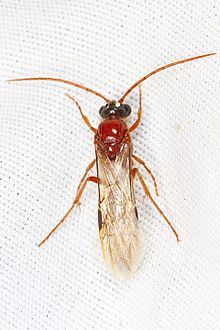| Tiphiid wasps | |
|---|---|

| |
| Tiphia sp. | |
| Scientific classification | |
| Domain: | Eukaryota |
| Kingdom: | Animalia |
| Phylum: | Arthropoda |
| Class: | Insecta |
| Order: | Hymenoptera |
| Superfamily: | Tiphioidea |
| Family: | Tiphiidae Leach, 1815 |
| Subfamilies | |
| |
The Tiphiidae (also known as tiphiid wasps,[1] flower wasps,[2][note 1] or tiphiid flower wasps[3]) are a family of large, solitary wasps whose larvae are parasitoids of various beetle larvae, especially those in the superfamily Scarabaeoidea.[4] Until recently, this family contained several additional subfamilies, but multiple studies have independently confirmed that these comprise a separate lineage, and are now classified in the family Thynnidae.[5][6]
The females of some Brachycistidinae are wingless, and hunt ground-dwelling (fossorial) beetle larvae.[4] The prey is paralysed with the female's sting, and an egg is laid on it so the wasp larva has a ready supply of food. As some of the ground-dwelling scarab species attacked by tiphiids are pests, some of these wasps are considered beneficial as biological control agents.[7]
Taxonomy
[edit]Tiphiid genera are classified as follows: [8][9][10]


Subfamily Brachycistidinae Kimsey, 1991
[edit]- Acanthetropis Wasbauer, 1958
- Brachycistellus Baker, 1907
- Brachycistina Malloch, 1926
- Brachycistis Fox, 1893
- Brachymaya Kimsey & Wasbauer 1999
- Colocistis Krombein, 1942
- Dolichetropis Wasbauer, 1968
- Glyptacros Mickel & Krombein, 1942
- Hadrocistis Wasbauer, 1968
- Paraquemaya Kimsey & Wasbauer, 1999
- Sedomaya Kimsey & Wasbauer, 1999
- Stilbopogon Mickel & Krombein, 1942
- Cabaraxa Nagy, 1974
- Cyanotiphia Cameron, 1907
- Epomidiopteron Romand, 1835
- Icronatha Nagy, 1967
- Krombeinia Pate, 1947
- Ludita Nagy, 1967
- Mallochessa Allen, 1972
- Megatiphia Kimsey, 1993
- Neotiphia Malloch, 1918
- Paratiphia Sichel, 1864
- † Philoponites Cockerell, 1915[11]
- Pseudotiphia Ashmead 1903
- Tiphia Fabricius, 1775
Examples
[edit]- Tiphia femorata Linden 1827
- Tiphia minuta Fabricius, 1775
Notes
[edit]- ^ Not to be confused with other flower wasps in Mutillidae, Scoliidae, or Thynnidae.
References
[edit]- ^ Obeysekara, Piyumi T.; Legrand, Ana (2014). "The Influence of Host Species and Location in the Host Detection Ability of Tiphiid (Hymenoptera: Tiphiidae) Parasitoids". Environmental Entomology. 43 (6): 1594–1602. doi:10.1603/EN13275. PMID 25289963. S2CID 31183862.
- ^ "Flower wasps". The Australian Museum. 2020. Retrieved September 9, 2023.
- ^ Kelaidis, Panayoti; Tankersley, Boyce; Zale, Peter (2019). "November 2019" (PDF). International Rock Gardener (119): 115 pp. ISSN 2053-7557. Retrieved September 9, 2023.
- ^ a b Brothers, Denis J. (1993). "Key to subfamilies of Tiphiidae". In Goulet, Henri; Huber, John T. (eds.). Hymenoptera of the World, an Identification Guide to Families. Ottawa, Ontario: Centre for Land and Biological Resources Research. pp. 178–185. ISBN 0-660-14933-8.
- ^ Pilgrim, E.; von Dohlen, C.; Pitts, J. (2008). "Molecular phylogenetics of Vespoidea indicate paraphyly of the superfamily and novel relationships of its component families and subfamilies". Zoologica Scripta. 37 (5): 539–560. doi:10.1111/j.1463-6409.2008.00340.x. S2CID 85905070.
- ^ Johnson, B.R.; et al. (2013). "Phylogenomics Resolves Evolutionary Relationships among Ants, Bees, and Wasps". Current Biology. 23 (20): 2058–2062. Bibcode:2013CBio...23.2058J. doi:10.1016/j.cub.2013.08.050. PMID 24094856.
- ^ Morais, Ryan (2020-07-28). "The Spring Tiphia: a natural enemy of the Japanese beetle". IPM & Entomology Lab. Retrieved 2024-06-06.
- ^ "Taxonomy for Tiphiinae". insectoid.info. Retrieved 13 May 2017.
- ^ "Tiphiinae". Fauna Europaea. Archived from the original on April 6, 2016. Retrieved 13 May 2017.
- ^ Lynn S. Kimsey; Marius Wasbauer (2006). "Phylogeny and Checklist of the Nocturnal Tiphiids of the Western Hemisphere (Hymenoptera: Tiphiidae: Brachycistidinae)". Journal of Hymenoptera Research. 15 (1): 9–25.
- ^ Antropov, A.V. (2014). "Aculeata Scopoli, 1763. The wasps, bees and ants (Insecta: Vespida=Hymenoptera) from the Insect Limestone (Late Eocene) of the Isle of Wight, UK" (PDF). Earth and Environmental Science Transactions of the Royal Society of Edinburgh. 104 (3–4): 335–446. doi:10.1017/S1755691014000103. S2CID 85699800.
Further reading
[edit]- Arnett, R. H. Jr. (2000) Segunda edición. American insects. CRC Press, Boca Raton, Londres,New York, Washington, D. C. ISBN 0-8493-0212-9
- Borror, D. J., DeLong, D. M., Triplehorn, C. A.(1976) cuarta edición. An introduction to the study of insects. Holt, Rinehart and Winston. New York, Chicago. ISBN 0-03-088406-3
Well, that’s interesting to know that Psilotum nudum are known as whisk ferns. Psilotum nudum is the commoner species of the two. While the P. flaccidum is a rare species and is found in the tropical islands. Both the species are usually epiphytic in habit and grow upon tree ferns. These species may also be terrestrial and grow in humus or in the crevices of the rocks.
View the detailed Guide of Psilotum nudum: Detailed Study Of Psilotum Nudum (Whisk Fern), Classification, Anatomy, Reproduction